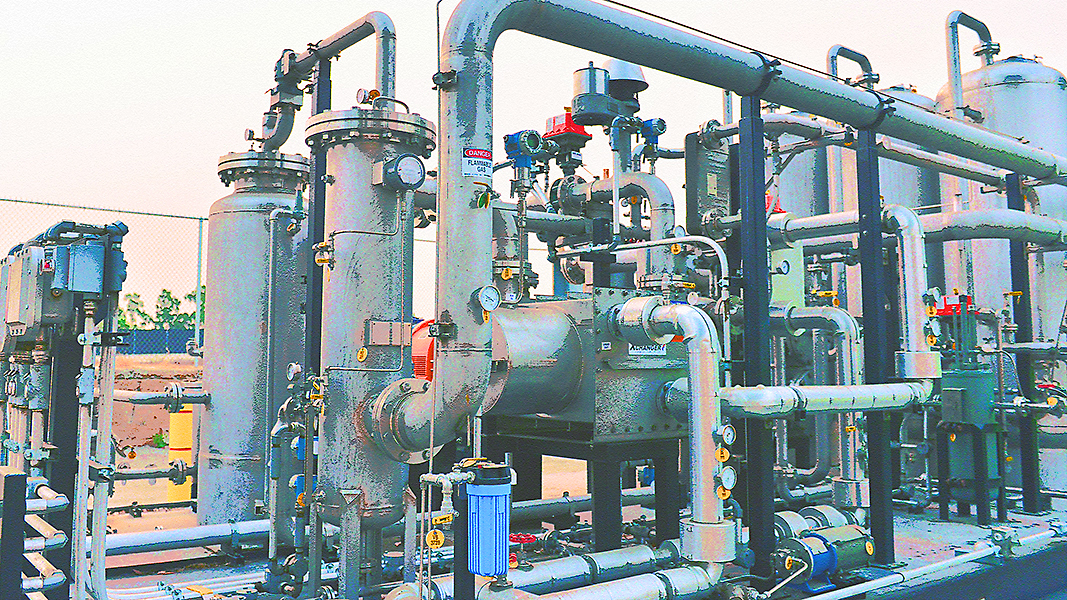Top: Biogas purification system used to produce RNG at the Los Angeles County Sanitation Districts’ Joint Water Pollution Control Plant. Photo courtesy of Sanitation Districts
On December 7, 2021, the U.S. EPA proposed a package of actions setting biofuel volumes for the Renewable Fuel Standard (RFS) program in a Notice of Proposed Rulemaking. These Renewable Volume Obligations (RVOs) determine how much renewable fuel will be required to be blended into the fuel supply and include a retroactive revision of the 2020 RVO downward, while increasing requirements in 2021 and 2022. The proposed volumes for cellulosic biofuel are 0.51 billion gallons in 2020; 0.62 billion gallons in 2021; and 0.77 billion gallons in 2022. Cellulosic biofuels include animal manure, crop residues, and/or separated yard trimmings that must contain a cellulosic content of at least 75%. “We appreciate EPA’s recognition of 20% to 25% annual growth in the D3/cellulosic category, 95% percent of which is RNG made from biogas,” noted Patrick Serfass, executive director of the American Biogas Council. “However, we have observed actual industry growth this year that is two times higher. We therefore encourage EPA to revise these cellulosic volumes upward in the final rule.”
The proposed rule does not contain any RVOs related to electricity from biogas at this time. In the package, EPA also proposed to add a 250 million gallon “supplemental obligation” to the volumes proposed for 2022 and stated its intent to add another 250 million gallons in 2023. This would address the remand of the 2014-2016 annual rule by the DC Circuit Court of Appeals in Americans for Clean Energy v. EPA. BioCycle Contributing Editor Michael Levin has reported on the legal journey of this ruling.
Biogas produced by anaerobic digesters (AD) that is conditioned into compressed or liquid renewable natural gas for use as vehicle fuel is categorized as D3 or D5 biofuels. In the credit marketplace, D3 biofuels have a higher value than D5; facilities that digest food waste only, or food waste blended with D3 cellulosic material, are considered D5 biofuels. In the proposed rule, EPA clarifies — but did not change — how it distinguishes between D3 and D5 biofuels. The following is an excerpt from the clarification: “In the preamble to the Pathways II final rule, we explained that predominantly cellulosic materials are materials that are at least 75% cellulose, hemicellulose or lignin by mass. We received multiple questions from stakeholders asking if they could generate D3 RINs for biogas produced in a digester if materials that are not predominantly cellulosic are used in the digester. We are proposing revisions to the definition of agricultural digester to clarify that each and every material processed must be predominantly cellulosic in order for the digester to qualify as an agricultural digester under the RFS regulations. This revision does not change the existing requirements but will make it easier for the regulated community to understand the limitations on generating D3 RINs for biogas produced in anaerobic digesters. However, EPA does allow renewable fuel to be produced by ‘other waste digesters’ and in some cases this fuel may qualify as cellulosic or partly cellulosic. A digester processing at least one type of material that is not at least 75% cellulosic content cannot be an agricultural digester and is instead an ‘other waste digester.’”
The comment period on EPA’s RVO proposal is open; all comments are due by February 4, 2022.













